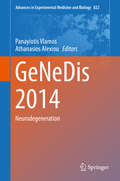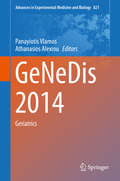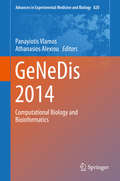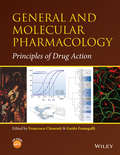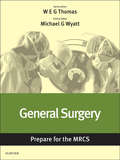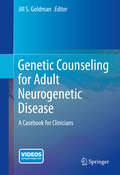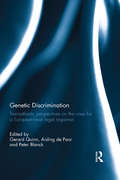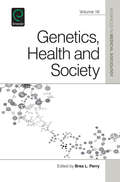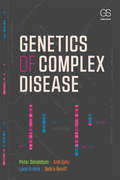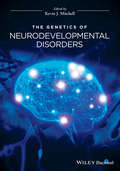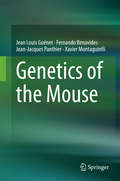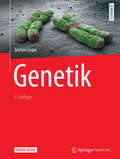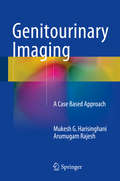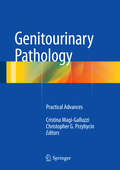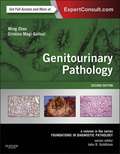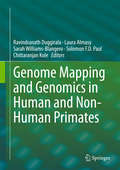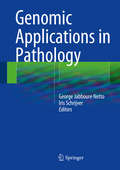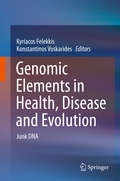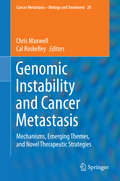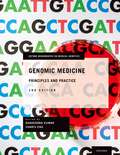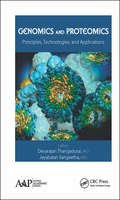- Table View
- List View
GeNeDis 2014: Neurodegeneration (Advances in Experimental Medicine and Biology #822)
by Panayiotis Vlamos Athanasios AlexiouThe 1st World Congress on Geriatrics and Neurodegenerative Disease Research (GeNeDis 2014), will focus on recent advances in geriatrics and neurodegeneration, ranging from basic science to clinical and pharmaceutical developments and will provide an international forum for the latest scientific discoveries, medical practices and care initiatives. Advances information technologies will be discussed along with their implications for various research, implementation and policy concerns. In addition, the conference will address European and global issues in the funding of long-term care and medico-social policies regarding elderly people. GeNeDis 2014 takes place in Corfu, Greece, 10-13 April 2014. This volume focuses on the sessions that address neurodegenerative diseases.
GeNeDis 2014: Geriatrics (Advances in Experimental Medicine and Biology #821)
by Panayiotis Vlamos Athanasios AlexiouThe 1st World Congress on Geriatrics and Neurodegenerative Disease Research (GeNeDis 2014), will focus on recent advances in geriatrics and neurodegeneration, ranging from basic science to clinical and pharmaceutical developments and will provide an international forum for the latest scientific discoveries, medical practices and care initiatives. Advances information technologies will be discussed along with their implications for various research, implementation and policy concerns. In addition, the conference will address European and global issues in the funding of long-term care and medico-social policies regarding elderly people. GeNeDis 2014 takes place in Corfu, Greece, 10-13 April 2014. This volume focuses on the sessions that address geriatrics.
GeNeDis 2014: Computational Biology and Bioinformatics (Advances in Experimental Medicine and Biology #820)
by Panayiotis Vlamos Athanasios AlexiouThe 1st World Congress on Geriatrics and Neurodegenerative Disease Research (GeNeDis 2014), will focus on recent advances in geriatrics and neurodegeneration, ranging from basic science to clinical and pharmaceutical developments and will provide an international forum for the latest scientific discoveries, medical practices and care initiatives. Advanced information technologies will be discussed concerning the various research, implementation and policy, as well as European and global issues in the funding of long-term care and medico-social policies regarding elderly people. GeNeDis 2014 takes place in Corfu Greece, 10-13 April 2014. This volume focuses on the sessions from the conference on computational biology and bioinformatics.
Geneeskundig jaarboek 2016: Geneesmiddelengids
by J.M.A. SitsenHet Geneeskundig Jaarboek 2016 is het recept voor iedereen die medicijnen voorschrijft, verkoopt of toedient. In het jaarboek vindt u de beschrijving van alle werkzame geregistreerde geneesmiddelen in Nederland, dat zijn er meer dan 2.000.
General and Molecular Pharmacology: Principles of Drug Action
by Francesco Clementi Guido FumagalliWith a focus on functional relationships between drugs and their targets, this book covers basic and general pharmacology, from a cellular and molecular perspective, with particular attention to the mechanisms of drug action – the fundamental basis for proper clinical use- without neglecting clinical application, toxicology and pharmacokinetics. • Covers cell and molecular pharmacology, bringing together current research on regulation of drug targets, at a level appropriate for advanced undergrad and graduate students • Discusses the relevance of pharmacokinetics and drug development for the clinical application of drugs • Presents material from the perspective of drug targets and interaction, the theoretical basis of drug action analysis, and drug properties • Focuses on structure-function relationships of drug targets – informing about their biochemical and physiologic functions and experimental and clinical pathways for drug discovery and development • Has a companion website that offers a host of resources: short additional chapters about methodology, topics at the forefront of research, all figures and tables from the book, and Power Point slides
General and Molecular Pharmacology: Principles of Drug Action
by Francesco Clementi Guido FumagalliWith a focus on functional relationships between drugs and their targets, this book covers basic and general pharmacology, from a cellular and molecular perspective, with particular attention to the mechanisms of drug action – the fundamental basis for proper clinical use- without neglecting clinical application, toxicology and pharmacokinetics. • Covers cell and molecular pharmacology, bringing together current research on regulation of drug targets, at a level appropriate for advanced undergrad and graduate students • Discusses the relevance of pharmacokinetics and drug development for the clinical application of drugs • Presents material from the perspective of drug targets and interaction, the theoretical basis of drug action analysis, and drug properties • Focuses on structure-function relationships of drug targets – informing about their biochemical and physiologic functions and experimental and clinical pathways for drug discovery and development • Has a companion website that offers a host of resources: short additional chapters about methodology, topics at the forefront of research, all figures and tables from the book, and Power Point slides
General Surgery: Key articles from the Surgery Journal
by William ThomasFor over 30 years Surgery has been at the forefront of providing high quality articles, written by experienced authorities and designed for candidates sitting the Intercollegiate surgery examinations. The journal covers the whole of the surgical syllabus as represented by the Intercollegiate Surgical Curriculum. Each topic is covered in a rolling programme of updates thus ensuring contemporaneous coverage of the core curriculum. For the first time the articles on general surgery are now available in ebook format. This collection of 100 articles will be ideal for revision for the Intercollegiate MRCS examination as well as a useful update for all seeking to keep abreast with the latest advances in this particular branch of surgery.A selection of key articles which will be an invaluable learning resource in preparation for the MRCS. Based on the Intercollegiate Surgical Curriculum for surgical trainees. Each article is fully referenced and includes an abstract which will aid revision. Includes self-assessment questions allowing testing of understanding of the contents.
Genetic Counseling for Adult Neurogenetic Disease: A Casebook for Clinicians
by Jill S. GoldmanThe adult patient diagnosed with or at risk for a neurogenetic disease has many questions and concerns for the genetic counselor, the neurologist, and other practitioners. Because of the emotional and potentially life-altering impact of these diseases on the patient and family, counseling can be especially challenging.A rare hands-on guide to the subject, Genetic Counseling for Adult Neurogenetic Disease deals with core issues that differentiate adult neurogenetic counseling from its more familiar pediatric counterpart. This innovative book with accompanying videos is designed to fill in deficits in this area typical of training programs in genetic counseling (which have pediatrics and prenatal concentrations) and neurology (which rarely cover genetic counseling). For each condition featured, chapters include a detailed overview of genetic symptoms, diagnostic criteria, and management, plus guidelines for asking, and answering, pertinent questions. The major concentration, however, is on genetic counseling issues and case histories illustrating these issues. As an added dimension, the accompanying videos depict representative issues and challenges in genetic counseling for specific diseases in addition to the basics of a neurological examination. Among the conditions discussed:Movement disorders, including Parkinson's disease.Dementias, including Alzheimer's disease.Stroke.Motor neuron diseases.Neuropathies and channelopathies.Adult muscular dystrophies.Neurocutaneous syndromes.Plus a section on neurological and neuropsychological evaluation.This is information that will stay relevant as technologies change and genetic understanding evolves. Genetic Counseling for Adult Neurogenetic Disease offers advanced clinical wisdom for genetic counselors as well as neurologists, neuropsychologists, and other referring clinicians.
Genetic Discrimination: Transatlantic Perspectives on the Case for a European Level Legal Response
by Gerard Quinn Aisling De Paor Peter BlanckAs genetic technologies advance, genetic testing may well offer the prospect of detecting the onset of future disabilities. Some research also forwards that certain behavioural profiles may have a strong genetic basis, such as the determination to succeed, or the propensity for risk-taking. As this technology becomes more prevalent, there is a danger that genetic information may be misused by third parties and that particular genetic profiles may be discriminated against by employers, by providers of social goods and services, such as insurance companies and even by educational facilities. This book explores the different forms and potential uses of genetic testing. Drawing together leading experts in disability law, bioethics, health law and a range of related fields, it highlights the ethical and legal challenges arising as a result of emerging and rapidly advancing genetic science. On examining transatlantic perspectives on the matter, chapters in the book ask whether the US Genetic Information Nondiscrimination Act (GINA) is proving to be an effective tool in addressing the issue of genetic discrimination and alleviating fears of discrimination. The book also reviews what insights may be gained from GINA within employment and health insurance contexts, and asks how the UN Convention on the Rights of Persons with Disabilities (CRPD) may impact similar debates within the European Union. The book focuses particularly on the legislative and policy framework in the European Union, with an emphasis on the gaps in protection and the scope for specific legislative action in this area. This book will be of great interest to scholars and students of discrimination law, bioethics and disability law, and will be of considerable use to legal practitioners, medical practitioners and policy-makers in this area.
Genetic Discrimination: Transatlantic Perspectives on the Case for a European Level Legal Response
by Gerard Quinn Aisling De Paor Peter BlanckAs genetic technologies advance, genetic testing may well offer the prospect of detecting the onset of future disabilities. Some research also forwards that certain behavioural profiles may have a strong genetic basis, such as the determination to succeed, or the propensity for risk-taking. As this technology becomes more prevalent, there is a danger that genetic information may be misused by third parties and that particular genetic profiles may be discriminated against by employers, by providers of social goods and services, such as insurance companies and even by educational facilities. This book explores the different forms and potential uses of genetic testing. Drawing together leading experts in disability law, bioethics, health law and a range of related fields, it highlights the ethical and legal challenges arising as a result of emerging and rapidly advancing genetic science. On examining transatlantic perspectives on the matter, chapters in the book ask whether the US Genetic Information Nondiscrimination Act (GINA) is proving to be an effective tool in addressing the issue of genetic discrimination and alleviating fears of discrimination. The book also reviews what insights may be gained from GINA within employment and health insurance contexts, and asks how the UN Convention on the Rights of Persons with Disabilities (CRPD) may impact similar debates within the European Union. The book focuses particularly on the legislative and policy framework in the European Union, with an emphasis on the gaps in protection and the scope for specific legislative action in this area. This book will be of great interest to scholars and students of discrimination law, bioethics and disability law, and will be of considerable use to legal practitioners, medical practitioners and policy-makers in this area.
Genetics, Health, and Society (Advances in Medical Sociology #16)
by Brea L. PerryThis volume focuses on critical issues surrounding the intersection of genetics, health, and society. It provides a critical examination of sociological and biomedical approaches to genomics, including strengths and limitations of each perspective.
Genetics of Complex Disease
by Peter Donaldson Ann Daly Luca Ermini Debra BevittGenetics of Complex Disease examines how the identification of genetic variations that increase or reduce the risk of common, genetically complex, diseases can be used to improve our understanding of the pathology of many common diseases; enable better patient management and care; and help with differential diagnosis. It starts with the quest
The Genetics of Neurodevelopmental Disorders
by Kevin J. MitchellNeurodevelopmental disorders arise from disturbances to various processes of brain development, which can manifest in diverse ways. They encompass many rare genetic syndromes as well as common, heritable conditions such as intellectual disability, autism, ADHD, schizophrenia and many types of epilepsy. The Genetics of Neurodevelopmental Disorders examines recent revolutionary advances in our understanding of the genetics of these disorders, exploring both basic discoveries and the translation of new findings into the clinical setting. The book begins by examining the genetic architecture and etiology of neurodevelopmental disorders. It describes the striking recent progress in identifying pathogenic mutations, which are grouped here based on the neurodevelopmental processes impacted. Subsequent chapters consider the use of cellular and animal models to elucidate the cascading consequences of such mutations, from molecular and cellular levels to emergent effects on neural circuits, brain systems and subsequent psychological development. The text concludes by examining the important clinical implications of the recent advances in the field, from recognition of the genetic causes in individual patients to development of new treatments and interventions. A timely synthesis, The Genetics of Neurodevelopmental Disorders is a unique and essential resource for neuroscientists, geneticists, neurologists and psychiatrists and an accessible and up-to-date overview for medical and science students.
The Genetics of Neurodevelopmental Disorders
by Kevin J. MitchellNeurodevelopmental disorders arise from disturbances to various processes of brain development, which can manifest in diverse ways. They encompass many rare genetic syndromes as well as common, heritable conditions such as intellectual disability, autism, ADHD, schizophrenia and many types of epilepsy. The Genetics of Neurodevelopmental Disorders examines recent revolutionary advances in our understanding of the genetics of these disorders, exploring both basic discoveries and the translation of new findings into the clinical setting. The book begins by examining the genetic architecture and etiology of neurodevelopmental disorders. It describes the striking recent progress in identifying pathogenic mutations, which are grouped here based on the neurodevelopmental processes impacted. Subsequent chapters consider the use of cellular and animal models to elucidate the cascading consequences of such mutations, from molecular and cellular levels to emergent effects on neural circuits, brain systems and subsequent psychological development. The text concludes by examining the important clinical implications of the recent advances in the field, from recognition of the genetic causes in individual patients to development of new treatments and interventions. A timely synthesis, The Genetics of Neurodevelopmental Disorders is a unique and essential resource for neuroscientists, geneticists, neurologists and psychiatrists and an accessible and up-to-date overview for medical and science students.
Genetics of the Mouse
by Jean Louis Guénet Fernando Benavides Jean-Jacques Panthier Xavier MontagutelliThis book, written by experienced geneticists, covers topics ranging from the natural history of the mouse species, its handling and reproduction in the laboratory, and its classical genetics and cytogenetics, to modern issues including the analysis of the transcriptome, the parental imprinting and X-chromosome inactivation. The strategies for creating all sorts of mutations, either by genetic engineering or by using mutagens, are also reviewed and discussed in detail. Finally, a last chapter outlines the methodology used for the analysis of complex or quantitative traits. The authors also discuss the importance of accurate phenotyping, which is now performed in the mouse clinics established worldwide and identify the limits of the mouse model, which under certain circumstances can fail to present the phenotype expected from the cognate condition in the human model. For each chapter an up-to-date list of pertinent references is provided. In short, this book offers an essential resource for all scientists who use or plan to use mice in their research.
Genetik: Die Abbildungen Des Buches (Springer-Lehrbuch)
by Jochen GrawVon Mendel bis zu Genomforschung und Gentechnologie reicht dieses Standardwerk der Genetik. In der 6. Auflage um ein Kapitel zur Epigenetik und um Fragen und Antworten ergänzt sowie aktualisiert, bietet dieses Lehrbuch eine umfassende Darstellung der klassischen und der molekularen Genetik. Cytogenetik, Entwicklungsgenetik, Humangenetik und Anthropologie sowie Neuro- und Verhaltensgenetik sind weitere wichtige Inhalte. Technikboxen bereichern das umfassende Themen- und Methodenspektrum des Buches. Dieses Buch vermittelt genetisches Grundlagenwissen für das gesamte Studium. Dabei unterstützen zahlreiche hervorgehobene Lernhilfen und Beispiele aus allen Bereichen der Genetik sowie farbige Abbildungen.
Genitourinary Imaging: A Case Based Approach
by Mukesh G. Harisinghani Arumugam RajeshGenitourinary Imaging - A Case Based Approach is a user friendly, portable guide that offers a comprehensive coverage of the subspecialty with an emphasis on all modalities. As subspecialty practice has become the norm in radiology, it becomes increasingly important to keep abreast of the latest information within the specialty that one is practising. The case based nature of this book, with modality independent content, allows the reader to assimilate practice specific information with ease. Full color images with tabular salient points, imaging algorithms and evidence based criterion support the text. Key points provide succinct explanations of the disease and an appropriate differential diagnosis, as well as providing a brief description of therapy and prognosis. Genitourinary Imaging - A Case Based Approach is aimed at residents and training and practicing genitourinary radiologists.
Genitourinary Pathology: Practical Advances (Foundations In Diagnostic Pathology Ser.)
by Cristina Magi-Galluzzi Christopher G. PrzybycinThis book provides a comprehensive, state-of-the art review of the genitourinary tumor pathology field and the most contemporary insights regarding specimen submission, histologic morphology, immunohistochemistry, and molecular studies useful in the diagnosis of genitourinary neoplasms. Discussion of the clinical implications of pathological findings is contributed by renowned clinicians in the field. This handsome volume guides the reader through the intricacies of genitourinary tumor pathology, diagnosis, reporting, and prognosis.Written by experts in the field, Genitourinary Pathology: Practical Advances is of great value to anatomic pathologists, urologists, fellows in genitourinary pathology, as well as upper level residents training in pathology.
Genitourinary Pathology E-Book: A Volume in the Series: Foundations in Diagnostic Pathology (Foundations in Diagnostic Pathology)
by Ming Zhou Cristina Magi-GalluzziGenitourinary Pathology, by Drs. Ming Zhou and Cristina Magi-Galluzzi, a volume in the Foundations in Diagnostic Pathology Series, packs all of today's most essential information on genitourinary pathology into a compact, high-yield format! Well-organized and segmented by type of infectious organism, the book's pragmatic approach complemented by abundant full-color, high-quality photomicrographs and clinical photos, and at-a-glance tables makes it easy to access the information you need to quickly and accurately detect and identify molecular and genetic mechanisms of disease. Consult this title on your favorite e-reader, conduct rapid searches, and adjust font sizes for optimal readability. Easily review normal histology before examining abnormal findings so you can avoid false positives. Gain a superb visual understanding of important histologic features with hundreds of full-color illustrations representing a wide variety of pathologic lesions. Benefit from the same highly practical format as other titles in this series: consistent headings throughout, summary boxes for pathologic and clinical features, high quality photomicrographs and clinical photos, and a logical organization by type of infectious organism. Avoid incorrect diagnoses with a separate section on artifacts and pitfalls that highlights common problems you may encounter. Get up-to-date, comprehensive coverage of the field, including new renal cell carcinoma subtypes and intraductal carcinoma of the prostate; newer immunohistochemical and molecular markers; and updates to the Gleason Grading system for prostate cancer, Fuhrman Grading system for renal cell carcinoma, and TNM classification for GU malignancies.
Genome Mapping and Genomics in Human and Non-Human Primates (Genome Mapping and Genomics in Animals #5)
by Ravindranath Duggirala Laura Almasy Sarah Williams-Blangero Solomon F.D. Paul Chittaranjan KoleThis book provides an introduction to the latest gene mapping techniques and their applications in biomedical research and evolutionary biology. It especially highlights the advances made in large-scale genomic sequencing. Results of studies that illustrate how the new approaches have improved our understanding of the genetic basis of complex phenotypes including multifactorial diseases (e.g., cardiovascular disease, type 2 diabetes, and obesity), anatomic characteristics (e.g., the craniofacial complex), and neurological and behavioral phenotypes (e.g., human brain structure and nonhuman primate behavior) are presented.Topics covered include linkage and association methods, gene expression, copy number variation, next-generation sequencing, comparative genomics, population structure, and a discussion of the Human Genome Project. Further included are discussions of the use of statistical genetic and genetic epidemiologic techniques to decipher the genetic architecture of normal and disease-related complex phenotypes using data from both humans and non-human primates.
Genomic Applications in Pathology
by George Jabboure Netto Iris SchrijverGenomic Applications in Pathology provides a state-of-the art review of the scientific principles underlying next generation genomic technologies and the required bioinformatics approaches to analyses of the daunting amount of data generated by current and emerging genomic technologies. Implementation roadmaps for various clinical assays such as single gene, gene panels, whole exome and whole genome assays are discussed together with issues related to reporting, including the pathologist’s role in interpretation and clinical integration of genomic tests results. Genomic applications for site-specific solid tumors and hematologic neoplasms are detailed, as well as genomic applications in pharmacogenomics, inherited genetic diseases, and infectious diseases. The latest iteration of practice recommendations and guidelines in genomic testing, put forth by stakeholder professional organizations such as the Association for Molecular Pathology and the College of American Pathologists, are also discussed in the volume, as well as regulatory issues and laboratory accreditation related to genomic testing.Written by experts in the field, Genomic Applications in Pathology provides a comprehensive resource that is of great value to practicing molecular pathologists, hematopathologists, other subspecialized pathologists, general pathologists, pathology trainees, oncologists, and geneticists.
Genomic Elements in Health, Disease and Evolution: Junk DNA
by Kyriacos Felekkis Konstantinos VoskaridesOver 98% of the human genome contains non-coding DNA sequences. For many years molecular biologists referred to this component of the genome as the “junk” DNA since it does not code for any “useful” protein product. Over the last years this notion changed significantly as scientists discovered that a large part of this DNA contains various genomic elements that have important roles in cell physiology. Genomic elements such as non-coding RNAs, transposons, splicing RNAs, DNA repeats and others were shown to play a significant role in regulating gene expression. In addition, all these elements were implicated to contribute in the pathogenesis or progression of various human diseases. In this book, the editor will attempt to describe all these genomic elements that constitute the junk DNA of the genome. For every genomic element, the physiologic role in the organism, its role in evolution and any possible involvement in human diseases will be discussed. Additionally, interaction between these elements in normal or pathologic condition will be discussed. Since a large amount of new knowledge is generated daily in regards to these genomic elements, this book will attempt to combine all the information in a single publication that can serve as a reference for future studies. The first part will discuss RNA elements such as microRNAs, long non-coding RNAs, piRNAs and splicing RNAs. The second part of the book will deal with transposons, retrotransposons and DNA transposons. Finally the third part of the book will discuss DNA elements that include DNA repeats, conserved non-coding sequences, distal genomic elements, introns, pseudogenes, CpG islands and telomeres. For miRNAs and CNVs a separate chapter will be dedicated to their role in human diseases since an extensive amount of information exists about these two elements.
Genomic Instability and Cancer Metastasis: Mechanisms, Emerging Themes, and Novel Therapeutic Strategies (Cancer Metastasis - Biology and Treatment #20)
by Chris Maxwell Cal RoskelleyMetastasis is the primary cause of mortality associated with cancer, and tumor genomic heterogeneity is a likely source for the cells that support cancer progression, resistance to therapy, and disease relapse. This book connects cancer metastasis with genomic instability in a comprehensive manner. Section 1 outlines the fundamental mechanisms responsible for these cellular and tissue phenotypes. Section 2 discusses in silico, in vitro, and in vivo models used for the experimental study of these processes. Section 3 reviews emerging themes (ex., microenvironment, mechanotransduction, and immunomodulation), and Section 4 highlights new therapeutic approaches to overcome the unique challenges presented by the heterogeneous and metastatic tumor. This book is intended for undergraduates and postgraduates with an interest in the areas of medicine, oncology, and cancer biology as well as for the content expert searching for thorough reviews of current knowledge in these areas.
Genomic Medicine: Principles and Practice (Oxford Monographs on Medical Genetics)
by Dhavendra Kumar and Charis EngThe first edition of Genomics and Clinical Medicine provided an overview of genomics-based advances in disease susceptibility, diagnosis, and prediction of treatment outcomes in various areas of medicine. Since its publication, the science of genomics has made tremendous progress, and exciting new developments in biotechnology and bioinformatics have created possibilities that were inconceivable only a few years ago. This completely revised second edition of Genomic Medicine reflects the rapidly changing face of applied and translational genomics in the medical and health context and provides a comprehensive coverage of principles of genetics and genomics relevant to the practice of medicine.
Genomics and Proteomics: Principles, Technologies, and Applications
by Devarajan Thangadurai Jeyabalan SangeethaThe book provides scope and knowledge on advanced techniques and its applications into the modern fields of biotechnology-genomics and proteomics. In this book, different genomics and proteomics technologies and principles are examined. The fundamental knowledge presented in this book opens up an entirely new way of approaching DNA chip technology,
